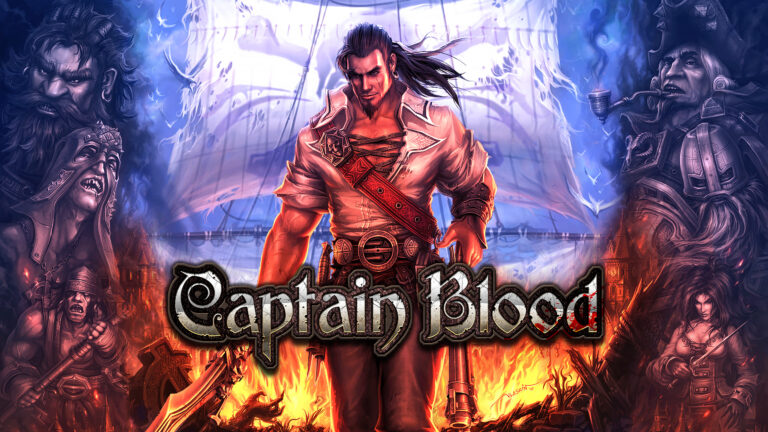In the world of pirate tales, discovering hidden treasure is a timeless trope. Captain Blood feels like one such treasure—buried deep within gaming history and uncovered after two long decades. Though its discovery brings excitement, what lies inside may not appeal to every modern gamer. This long-lost game, which began development in the early 2000s, is now finally playable thanks to years of persistence and a touch of luck. But does it still have a place in today’s fast-moving gaming world?
The Long Voyage: From Legal Trouble to Final Release
Captain Blood‘s development history is nearly as dramatic as its story. First announced in 2003, the game was meant to be a gritty adaptation of the Captain Blood novels and even rival action-packed titles of the time, such as God of War and The Suffering. However, it quickly fell into a cycle of legal issues, publisher bankruptcies, and constant studio changes. The project became trapped in development hell, undergoing multiple restarts before finally being rescued.
How SNEG and Seawolf Studio Saved the Project
A leaked build of the game surfaced in 2020, reigniting interest. Eventually, SNEG Ltd. acquired the rights and, with Seawolf Studio, brought the project to completion. This long, rocky road adds a layer of nostalgia and makes Captain Blood feel like a time capsule from the early 2000s—a reminder of gaming’s evolving history.
Core Gameplay: Classic Hack-and-Slash Action
At its heart, Captain Blood is a traditional hack-and-slash action game. It sticks closely to the genre’s formula from the early PS2 days: simple melee combos, flashy finishers, and repetitive enemy waves. Combat relies heavily on QTEs (Quick Time Events), especially during boss fights, reinforcing the game’s vintage DNA.
Weapon-Stealing: A Clever Twist on Combat
One standout feature is the weapon-stealing mechanic, which lets players grab weapons from enemies mid-battle. This adds tactical variety and power, evoking the thrill of being a cunning pirate. Unfortunately, the novelty wears off quickly due to repetitive execution and limited enemy diversity.
Enemy Variety and Combat Depth
The enemies in Captain Blood fall into two main categories: basic soldiers and slow, heavy bosses with massive health bars. Their attack patterns are easy to predict, making battles feel less intense as the game progresses.
A Missed Opportunity in Mid-Game Stages
As the game moves forward, rather than introducing new enemies, it simply increases their number—diluting the sense of progress. Compared to contemporaries like God of War II, which featured evolving enemy designs and smart boss fights, Captain Blood feels static. Still, its charm may satisfy those who miss the simplicity of older games.
Character Switching and Gameplay Variety

In some levels, you’ll take control of Captain Blood’s companions, adding a bit of variety. This mechanic is reminiscent of games like Shadow of Rome, but the main character Peter Blood remains the game’s most compelling figure, thanks to his strong personality and screen presence.
Naval Combat: Brilliant Idea, Flawed Execution
Naval battles were supposed to be a game-changer. Players fire ship cannons while fighting off boarding enemies, a concept that sounds thrilling. Sadly, poor design and repetitive enemy behavior turn these sequences into sluggish chores.
Unbalanced Gameplay and Artificial Difficulty
The game struggles to balance pure action and tactical elements. Naval enemies follow predictable routines and lack challenge—except during the final levels, where difficulty is artificially increased by flooding the screen with foes rather than enhancing AI.
Graphics and Sound: A Mixed Bag
The visual presentation is oddly compelling. It combines chunky character models, simple textures, and basic lighting—reminiscent of early-2000s graphics. Despite updated resolution and frame rates, the game maintains its retro soul, for better or worse.
Sound Design and Dialogue Issues
Musically, Captain Blood offers an epic soundtrack, but voice lines and sound effects feel generic. Dialogues are hard to follow without subtitles—which are sometimes delayed—and the overall audio mix buries spoken lines under loud background music.
The Plot: A Classic Pirate’s Tale
You play as Captain Peter Blood, a rogue pirate who captures a Spanish ship after they attack a British port. Onboard, he meets Lord Langford, whose daughter has been kidnapped by the feared pirate Jack Easterling. What follows is a straightforward yet charming pirate journey filled with action, betrayal, and buried treasure.
Performance: Technical Flaws That Break Immersion
The game suffers from frame rate issues, especially during chaotic ship battles. Small bugs—like character glitches and texture loading delays—also pop up, reminding players of older titles’ poor optimization and rushed development cycles.
Final Verdict: A Historic Curiosity, Not a Modern Masterpiece
For retro gaming enthusiasts and fans of PS2-era action titles, Captain Blood offers a glimpse into a bygone era. It’s a historical piece more than a must-play game—something to be appreciated by those interested in the evolution of game design.
Is Late Better Than Never?
Going back to our original question—Is it better late than never?—the answer depends on your taste. If you’re nostalgic for vintage games and fascinated by forgotten titles, Captain Blood is a diamond in the rough. But for modern players expecting polish, depth, and innovation, it may feel like a shipwreck frozen in time.
Conclusion: A Pirate Tale Lost at Sea but Not Forgotten
Captain Blood is a rare case of a lost game resurrected. Its dated design, uneven gameplay, and charming imperfections turn it into more than just an old game—it becomes a testament to how far gaming has come. Whether you enjoy it or not, it’s a journey worth studying, if not sailing yourself.
